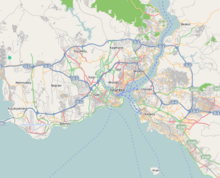Florya Atatürk Marine Mansion
| Florya Atatürk Deniz Köşkü | |

View of the mansion from the beach
|
|
| Established | 1993 |
|---|---|
| Location | Florya, Bakırköy, Istanbul, Turkey |
| Coordinates | 40°58′21″N 28°46′57″E / 40.97260°N 28.78254°ECoordinates: 40°58′21″N 28°46′57″E / 40.97260°N 28.78254°E |
| Type | Historic house museum |
| Website | www.florya-ataturk-kosku.html |
Florya Atatürk Marine Mansion, (Turkish: Florya Atatürk Deniz Köşkü) is a historic presidential residence located offshore in the Sea of Marmara in the Florya neighborhood of the Bakırköy district in Istanbul, Turkey.
It was built in 1935 by the municipality of Istanbul, for Mustafa Kemal Atatürk's recreational use. The building is a historic house museum today.
Designed in the Bauhaus style by architect Seyfi Arkan, who was given the commission in 1935 by the municipality of Istanbul, the mansion was completed on August 14 the same year, and was gifted to Atatürk.
The building is constructed on steel piles driven into the seabed and is connected to the sandy beach about 70 m (230 ft) away with a wooden pier. The L-shaped, one-floor mansion consists of a reception hall, a reading room, bedrooms and bathroom. There are also service and staff rooms at the complex. The total area covered by the mansion including the pier is 602 m2 (6,480 sq ft).
A grove was created in the yard of the ruined Agios Stefanos Monastery as the garden for the mansion on Atatürk's taking possession. This grove is called "Florya Atatürk Grove" (Turkish: Florya Atatürk Korusu) and is today a public park. The mansion is considered an example of the "Turkish Early Republican architecture".
During the period he stayed at Dolmabahçe Palace, Atatürk came to the mansion by boat and enjoyed swimming surrounded by local people. He used the mansion for the last three years of his life as a summer office as well as for recreation. In 1936, he stayed from June 6 until July 28 at the mansion. His last stay was on May 28, 1938, about six months before his death.
The mansion was also used for important receptions and scientific meetings. Among its famous visitors were Prince Edward, Duke of Windsor and his wife Wallis, Duchess of Windsor.
...
Wikipedia

